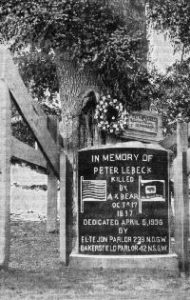A Brief Overview of the History of Lebec

Following the close of Fort Tejon in 1864, records indicate that a small community of people stayed in the beautiful Castac Lake Valley located at the top of the Grapevine Canyon. Most of these residents were civilian workers living in a small settlement south of the military post. They had turned to farming or working on the neighboring ranches such as the great Tejon Ranch, or were trying their luck at mining.
It is not known for sure when the community of Lebec took its name, but it was no doubt the result of a speech made by Edward Fitzgerald Beale, owner of the neighboring Tejon Ranch. In an April 1888 address at Bakersfield, Beale proposed to lay out a town and divide the lands adjoining it into ‘villa lots”. This he said would be called “Lebecque”, named for the trapper, Peter Lebeck, (as his name was carved above the grave) who was killed by a bear and buried at Fort Tejon in 1837.

Beale said, “The town will be in the vicinity of the grave, on or near the site of the old military post”, which would have been on ranch property. Somehow Beale’s proposal never came about; however, a settlement did develop three miles south of the Fort on property adjoining Tejon Ranch.
As the population grew along the increasingly traveled road, so did the need for postal services. Since the Fort’s post office had closed many years earlier, the citizens of the area were able to have one reestablished there in March 1895 as the Tejon Post Office. That same year, Charles L. Wood had made application for postal services to begin for the community of Lebec.
When his request was granted in September 1895, the Tejon facility was closed and combined with the new office at Lebec. Therefore, the year 1895 serves as the official beginning of the community of Lebec.

Mr. Wood located the postal service in a large adobe building next to his home approximately two miles south of the Fort. This building was built in 1886 as a dairy by a Swiss farmer who soon found that range cattle did not make for the best of milk cows. A year later, Mr. Wood was succeeded as Postmaster by Charles Hollenbeck, who reestablished the Post Office at his general store a mile further to the south – where the Lebec Hotel would later be built.
It was at this new location that the community grew as a popular road stop and gathering place for the area residents. A large barn nearby housed the fresh teams of mules for the borax mines in Lockwood Valley. By the turn of the century, horseless carriages began speeding through the valley straight-aways at 30 mph!
The next major influence to the community came with the discovery of the Taft oil fields. The oil needed to be transported, which gave way to the oil pipelines that were run up through the mountain pass and on to the San Pedro harbor. Four pumping plants were established near Lebec, which greatly increased the population there.
With the paving of the well-known Ridge Route Roadway in 1919, our serene mountain community became a popular rest stop and summer resort. Auto court cottages and “a garage for the accommodation of the motoring public” were added along the road.


In May of 1921, one of the finest resort hotels in all of southern California was opened in Lebec. Even the Hollywood crowd could not resist its attractive beauty.
Acreage in the nearby canyons was soon subdivided into mountain cabin sites. In 1925, Jack Dempsey was the first to tee-off at the new Lebec Golf Course located on the shores of Castac Lake.
In the 1930’s, several significant events occurred. Charles Lindberg, “still a popular public figure just three years after his transcontinental flight”, tested a large folded wing glider in the hills to the east of Lebec. Along the road, a restaurant, service station and school had opened. The local baseball team was playing against Newhall, Lamont, Arvin and Bakersfield.


In 1939, a welcome center referred to as the “Gateway to Kern County” was established here. The site included San Joaquin Valley’s building and exhibit from the World’s Fair in San Francisco. It was called the “Florafaunium” for the plant and animal life exhibited there. After being badly damaged in the 1952 Tehachapi earthquake, the exhibits were moved to the Kern County Museum and building was demolished.
The increased speed of travel past the little community of Lebec greatly quieted its growth in the second half of its first century of existence. It became, and continues to be, a tranquil mountain hideaway for the retired and for commuters to the sprawling urban cities to the north and south.

Lebec did experience one more burst of notoriety in its first century. In 1991, it became the headquarters for the famed artist Christo, who displayed his work entitled “The Umbrellas, Joint Project for Japan and the U.S.A.” along the Ridge Route corridor. Over 1,700 of the twenty-foot high yellow umbrellas filled the mountain pass bringing thousands of visitors to Lebec daily that October. It has once again returned to its peaceful, quiet existence only to await future adventures in the century ahead.
Additional information may be found in “A View from the Ridge Route” series
